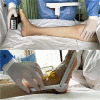Prevention of muscle atrophy in ICU patients without nerve injury by neuromuscular electrical stimulation: a randomized controlled study
- PMID: 35974369
- PMCID: PMC9380284
- DOI: 10.1186/s12891-022-05739-2
Prevention of muscle atrophy in ICU patients without nerve injury by neuromuscular electrical stimulation: a randomized controlled study
Abstract
Background: Extensive muscle atrophy is a common occurrence in orthopaedics patients who are bedridden or immobilized. The incidence is higher in intensive care unit (ICU) inpatients. There is still controversy about how to use neuromuscular electrical stimulation (NMES) in ICU patients. We aim to compare the effectiveness and safety of NMES to prevent muscle atrophy in intensive care unit (ICU) patients without nerve injury.
Methods: ICU patients without central and peripheral nerve injury were randomized into experimental group I (Exp I: active and passive activity training (APAT) + NMES treatment on the gastrocnemius and tibialis anterior muscle), experimental group II (Exp II: APAT + NMES treatment on gastrocnemius alone), and control group (Ctl: APAT alone). Changes in the strength of gastrocnemius, the ankle range of motion, and the muscle cross-section area of the lower leg were evaluated before and after the intervention. Also, changes in prothrombin time, lactic acid, and C-reactive protein were monitored during the treatment.
Results: The gastrocnemius muscle strength, ankle joint range of motion, and cross-sectional muscle area of the lower leg in the three groups showed a downward trend, indicating that the overall trend of muscle atrophy in ICU patients was irreversible. The decrease in gastrocnemius muscle strength in Exp I and Exp II was smaller than that in the control group (P < 0.05), but there was no difference between Exp I and Exp II. The decrease in active ankle range of motion and cross-sectional area of the lower leg Exp I and Exp II was smaller than that in the control group (P < 0.05), and the decrease in Exp I was smaller than that of Exp II (all P < 0.05). The curative effect in Exp I was better than in Exp II. There were no significant differences in the dynamic changes of prothrombin time, lactic acid, and C-reactive protein during the three groups (P > 0.05).
Conclusion: In addition to early exercise training, NMES should be applied to prevent muscle atrophy for patients without nerve injury in ICU. Also, simultaneous NMES treatment on agonist/antagonist muscle can enhance the effect of preventing muscle atrophy.
Trial registration: This study was prospectively registered in China Clinical Trial Registry ( www.chictr.org.cn ) on 16/05/2020 as ChiCTR2000032950.
Keywords: Efficacy; ICU; Muscular atrophy; NMES; Prevention; Safety; Strategy.
© 2022. The Author(s).
Conflict of interest statement
The authors declare that they have no competing interests.
Figures








Similar articles
-
Feasibility of neuromuscular electrical stimulation in critically ill patients.J Crit Care. 2014 Dec;29(6):1082-8. doi: 10.1016/j.jcrc.2014.06.024. Epub 2014 Jun 30. J Crit Care. 2014. PMID: 25108833
-
Neuromuscular electrical stimulation for intensive care unit-acquired weakness: protocol and methodological implications for a randomized, sham-controlled, phase II trial.Phys Ther. 2012 Dec;92(12):1564-79. doi: 10.2522/ptj.20110437. Epub 2012 Mar 15. Phys Ther. 2012. PMID: 22421734 Free PMC article. Clinical Trial.
-
Neuromuscular electrical stimulation prevents muscle wasting in critically ill comatose patients.Clin Sci (Lond). 2015 Mar;128(6):357-65. doi: 10.1042/CS20140447. Clin Sci (Lond). 2015. PMID: 25296344 Clinical Trial.
-
Neuromuscular electrical stimulation. An overview and its application in the treatment of sports injuries.Sports Med. 1992 May;13(5):320-36. doi: 10.2165/00007256-199213050-00003. Sports Med. 1992. PMID: 1565927 Review.
-
A review of the efficacy of neuromuscular electrical stimulation in critically ill patients.Physiother Theory Pract. 2014 Jan;30(1):6-11. doi: 10.3109/09593985.2013.811567. Epub 2013 Jul 15. Physiother Theory Pract. 2014. PMID: 23855510 Review.
Cited by
-
Evaluating Muscle Mass Changes in Critically Ill Patients: Rehabilitation Outcomes Measured by Ultrasound and Bioelectrical Impedance.Healthcare (Basel). 2024 Oct 25;12(21):2128. doi: 10.3390/healthcare12212128. Healthcare (Basel). 2024. PMID: 39517341 Free PMC article.
-
Effect of neuromuscular electrical stimulation combined with early rehabilitation therapy on mechanically ventilated patients: a prospective randomized controlled study.BMC Pulm Med. 2023 Jul 21;23(1):272. doi: 10.1186/s12890-023-02481-w. BMC Pulm Med. 2023. PMID: 37480065 Free PMC article. Clinical Trial.
-
Acute Sarcopenia: Systematic Review and Meta-Analysis on Its Incidence and Muscle Parameter Shifts During Hospitalisation.J Cachexia Sarcopenia Muscle. 2025 Feb;16(1):e13662. doi: 10.1002/jcsm.13662. Epub 2024 Dec 17. J Cachexia Sarcopenia Muscle. 2025. PMID: 39690131 Free PMC article.
-
The effect of in-bed cycling combined with high flow nasal cannula treatment on arterial oxygen and respiratory dynamics in patients with severe respiratory failure: A retrospective study.Pak J Med Sci. 2024 Sep;40(8):1813-1818. doi: 10.12669/pjms.40.8.9471. Pak J Med Sci. 2024. PMID: 39281233 Free PMC article.
-
Efficacy of Yijinjing for Soft Tissue Improvement in Patients with Non-specific Chronic Neck Pain: Study Protocol for a Multicenter Randomized Controlled Trial.BMJ Open. 2025 Apr 10;15(4):e094851. doi: 10.1136/bmjopen-2024-094851. BMJ Open. 2025. PMID: 40216430 Free PMC article.
References
Publication types
MeSH terms
Substances
Grants and funding
LinkOut - more resources
Full Text Sources
Research Materials

